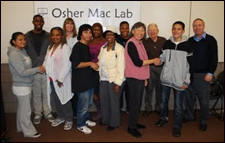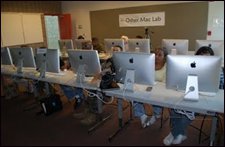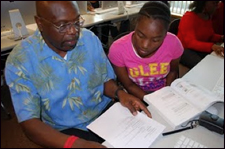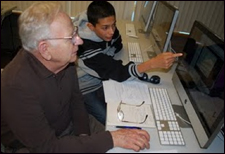Students Master Digital Media Skills Teaching Tech to Older Adults
Digital Geniuses shine in unique opportunity
Your content has been saved!
Go to My Saved Content.Innovative teaching and student engagement happens when prepared students meet opportunity at the crossroads of education. I saw an example of this powerful intersection when my students -- the Crenshaw High School Digital Media Team -- got the opportunity to teach digital photography and podcasting to adults 50+ at Cal State Dominguez Hills' Osher Lifelong Learning Institute (OLLI). The team of eight tenth- and eleventh-grade students had completed a certification class for iPhoto, iMovie, and GarageBand.

With the ISTE NETS standards as the foundation, the Crenshaw High School Digital Media Team used their collaboration, communication, critical thinking, problem solving and decision-making skills to teach others the same way I taught them. These students got a great resume-building opportunity, and I got a useful means of evaluating the effectiveness of my non-traditional teaching methods.
Project Background
In the Spring of 2011, I was offered the opportunity to "volunteer" teach a class of older adults at the brand new Osher Mac lab at Cal State Dominguez Hills (CSUDH). Juggling the Crenshaw High School Developing Digital Media Geniuses after-school program -- along with rampant education budget cuts in California -- I didn't have time and couldn't afford to teach the class on a volunteer commitment.

In the midst of explaining my decision to Jim Bouchard, Senior Program Development Specialist & OLLI Coordinator at CSUDH, the creative light bulb went off in my head and electrified my brain with a solution. I pitched Jim on the idea of letting the Crenshaw High School Digital Media Team teach the class. After all, the group of eight had successfully passed my technology class with the majority of them earning digital media certification in iPhoto, iMovie and GarageBand. Under my supervision and guidance, Jim agreed to let these young people be the first group of volunteer high school teachers to host a class via the Osher Lifelong Learning Institute.
Project Logistics and Tools
Professional Development Tuesdays were the best days to host the weekly class at the OLLI computer lab. School is out at 1:30 pm, which provided time for the Crenshaw Digital Media Team to meet for an hour to review the lesson plan they prepared the day before. Loading everyone into my SUV by 2:45 gave us more than enough time to travel safely to the CSUDH campus.

The eight-week course was divided into two equal four-week sessions covering digital photography and podcasting. Many of the semi-retired and retired adults were eager to learn how to organize, edit and make slideshows of their vacation and family pictures. The podcasting classes were a new digital media adventure for the OLLI students because most of them had never produced their own podcast or short YouTube videos. Being prepared with a clear lesson plan was a mandatory component for this high school student teaching project.

When we give our students the necessary tools to be creative, magic happens. For the underprivileged South Los Angeles inner city students I serve, I make it a priority to provide them with the best. The digital tools used include a Macbook cart, Nikon D60 and D90, several Nikon Coolpix point and shoot cameras with HD video capabilities, several Cannon HD video recorders, tripods, boom mics, wireless mics, and lighting when needed. Access to all of this professional level equipment imparts a high level of confidence, responsibility and excitement among students as well as parents.
Unexpected Mentorship Opportunities
The most unexpected outcome of this intergenerational partnership was the mentorship the Crenshaw Digital Media Team received from their adult students. The team and I were so concerned about delivering excellent comprehensive lessons that we didn't think about asking the OLLI students to tell us about their careers until after the Los Angeles Times published an article stating one of the retirees was a neuropharmacologist. During the next class I asked the adult students to tell us about their former careers, which included retired health care professionals, a video production teacher, a machinist, a retired scientist and LAUSD educator to name a few. The collaboration between student teacher and adult student participants transformed into a bonded, life-changing experience for everyone.
10 Steps to Implementing a Mentoring Program
This innovative 21st Century learning experience can be implemented at any high school as long as you have the time and tools to support your students. Once they complete the prerequisite digital media training class, you're ready to go. Below are a few suggested steps to take:
1) Online research
Find out if a local university offers intergenerational programs. Osher Lifelong Learning Institute is a national organization.
2) Financial commitment
The high school instructor MUST be financially committed to the project. The return on investment (ROI) is priceless.
3) Solid core group
Organize a reliable and committed group of students. Enlist a couple of substitute students as backup. Make sure all students have a solid foundation in ISTE's NETS for students.
4) Opportunities
Contact your local university's extended education department to inquire about opportunities for your students to teach and/or collaborate with instructors of the scheduled classes. Make sure you talk to the director or dean of the department.
5) Plan ahead
If the university is interested, schedule your class or participation for the following semester. For example, if you make an agreement in the fall, schedule your participation for the following spring. This will give you the time required to properly plan the successful implementation of your student-led class.
6) Student commitment
Issue a commitment agreement outlining the requirements of the project for students and parents to sign.
7) Encourage ownership
Meet two times per week: one day for student lesson planning and one day for teaching at the partner university. Advise your students on how to format a lesson plan. Leave the room while they create the lesson for the week. Return in 45 minutes to review and assist with revisions.
8) Organization
Students must create a checklist for books, paperwork, flash drives and equipment. Rotate this weekly responsibility among your students.
9) Make it official
Be sure all required district paperwork is complete.
10) Make it personal
On the first day of class at the university, begin with everyone introducing him- or herself and sharing a little bit about his or her professional background. Once the supervising instructor sets the tone for the class, step back and watch your students shine.
Have you introduced any intergenerational teaching/learning opportunities to your students? Please share them in the comments below.